























NATE SCHWARTZ
The Coast Guard Cutter Orcas (WPB1327) has been decommissioned after 35 years of service to the South Coast. The 110-foot cutter vessel replaced the Cutter Pulaski back in 1989, becoming the sixth Coast Guard cutter to call Coos Bay home.
Used as multi-mission resource, the Orcas conducted everything from search-andrescue missions, to national defense, and environmental protection. The ship conducted boardings for police and fisheries, escorted high value assets, and ensured infrastructure safety.
According to a US Coast Guard release, the primary mission of the Orcas was “to enforce federal laws and regulations along the coast of Washington and Oregon, particularly with regards to fisheries.”
The Orcas, and its 21-person crew, completed missions as far away as

Ketchikan, Alaska, where the crew completed an 11-week dry docking operation. For the most part, the Orcas main focus was here in the Coast Guard’s 13th District.
These larger vessels, called Island-class patrol vessels, are now considered a relic of the 80’s coast guard, as many of them have now been decommissioned.
Of the 49 Island-class boats built for the coast guard, only three are still in commission.
The Island-class replaced the Cape-class cutters, which were older, 95-foot vessels.
The Island-class, also known as WPB110’s for their hull numbers and length, were more versatile and technologically capable.
Each Island-class cutter is named, unsurprisingly, after U.S. islands. Orcas was named after the largest of the San Juan Islands in Washington’s Puget Sound, not the sea’s iconic pod predators, the Killer Whale.
In an attempt to refit many of the old class
cutters under the Integrated Deepwater System Program, the Coast Guard began trying to expand and update the Island-class. 8 of them were modified back in the early 2000’s, but ultimately structural flaws derailed the project during sea testing.
The Island-class are now being replaced by Sentinelclass cutters, also known as Fast Response Cutters (FRCs). Named after Coast Guard heroes, these cutters are larger and more modern choices.
A decommission ceremony for the Orcas took place in late-spring of 2024. The commander for the 13th District, Rear Admiral Charles Fosse, spoke to honor the crew, the ship, and their 35 years of service. Lieutenant Brendan O’Farrell, the Orcas last commanding officer, had this to say about the ship.
“From training allied nation maritime forces, conducting the largest-ever
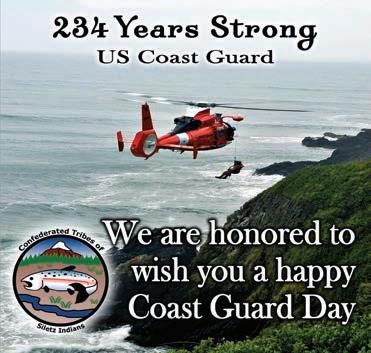
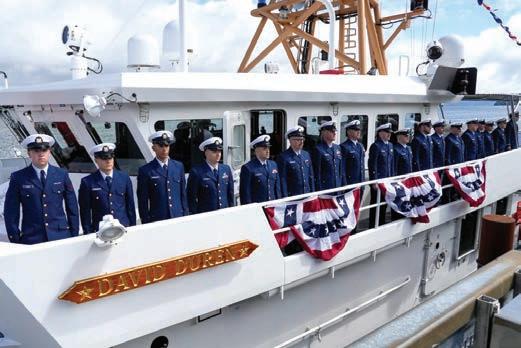

From Page 2
cocaine seizure in the history of the Pacific Northwest, and saving countless lives and hundreds of millions of dollars’ worth of property on the Pacific Ocean - Orcas has done it all.”
“This ship, one of the last of its kind, is an old American-made workhorse built to endure the harsh Pacific waves. I’m extremely proud and blessed to have served with the finest crew in the fleet.”
Though the Coast Guard will no longer have a cutter vessel in Coos Bay, the FRCs slated to replace the Orcas have already begun to arrive in Astoria, Oregon. Just two months on from the Orcas decommissioning ceremony, a commissioning ceremony was held to welcome the Coast Guard Cutter David Duren, the first of three new cutters expected
to arrive in District 13.
The new cutter is named after Master Chief Petty Officer David Duren, who served from 1965 to 1993, earning two Coast Guard Medals for exemptional heroism and the Douglas Munro Inspirational Leadership Award.
The World newspaper originally announced the decommission and replacement for 2021, as was the Coast Guard’s original plan, however undisclosed delays kept the Orcas going for an additional three years. The last three WPB110’s are expected to leave service by next year.
Most of the Island-class cutters have been sent to other nations or are currently being staged in Baltimore in anticipation of an international transfer. Speculation online rumors that the Orcas could end up in Greece when all is said and done. A nice Mediterranean retirement seems fitting for the South Coast’s guardian vessel of 35 years.
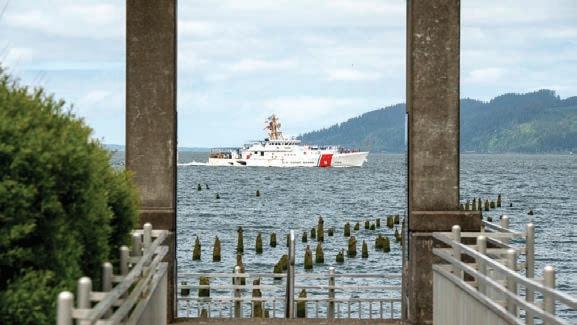
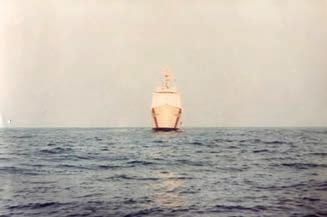
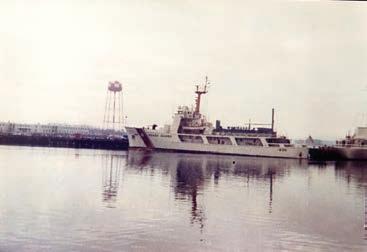
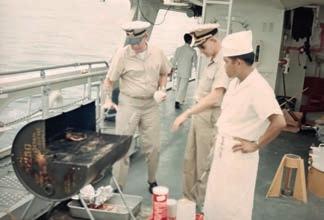
WILL LOHRE Country Media, Inc.
For 30 years, the Coast Guard Cutter Alert called Astoria its home port. Now, after years of patrolling the coasts of Oregon and the waters of the Pacific, it has returned to the East Coast, where it will be stationed in Cape Canaveral, Florida.
The Alert is a 210’ medium endurance cutter (MEC), built in Maryland and commissioned in 1969. When the Alert came to the Pacific Northwest, one lifelong St. Helens resident couldn’t believe it.
“[I found out] it was coming to the west coast, and I couldn’t believe it,” Jack Zielaskowski said.
Jack Zielaskowki served on the cutter Alert from 1969 until October of 1970, when he was in the Coast Guard, early in the ship’s days in the Atlantic. A son of a Boise Cascades mill worker, Zielakowski joined the Coast Guard to fulfill his duty to the United States during the Vietnam War.
Zielaskowki’s time took him all the way across the country.
“Lil’ hometown boy from St. Helens, Oregon
headed to New York, the big city,” Zielaskowski said. “It was kind of overwhelming.”
Zielaskowski’s first post was at a fort that had a direct view of the Statue of Liberty right through his backdoor.
After bouncing around on various assignments, Zielaskowski joined Alert and served as an engineer. An avid photographer, Zielaskowski took photos of the boat and things that happened on and off the boat. He documented everyday life. The Columbia River Maritime Museum has all the photos Zielaskowski took when he served.
While on the Alert, Zielaskowski said that most of the crew’s time was spent guarding the coast from Russian vessels and other threats. Outside of that, some of their other duties involved overseeing the demolition of an old “liberty ship,” and helping “locate a rocket that was launched from Cape Canaveral.”
While it was a lot of hard work on the ship, the crew still found time for simple things like grilling, fishing, and spending their
free time together.
When Zielaskowski returned from his time in the Coast Guard, he started at Boise Cascade three days later. He worked in the company for over 40 years.
With the Alert being more than half a century old, it’s changed a lot over the years since Zielaskowski was aboard. According to the Alert’s webpage on the Coast Guard Website, in 1993, the Alert returned to Curtis Bay for “Mid-life Maintenance Availability (MMA),” which extended her service life well into the twenty-first century. These improvements included the modernization of living and working quarters for the crew, installation of updated electronics systems, and redesign of major engineering and damage control spaces. Following MMA, Alert was assigned to Astoria, Oregon, in the fall of 1994.
Location and hardware aren’t the only things that have changed for the Alert. Zielaskowski noted that one of the crew members is now integrated with female crew members, something that was not part of his time in the service.
Current Commanding Officer for the Alert Lee Crusias, said that the ship blazed trails in that regard
and, in 2012, became “the first 210’ MEC to berth female crew,” and to this day, remains integrated.
When asked whether a move to a new homeport
See ALERT, Page 5
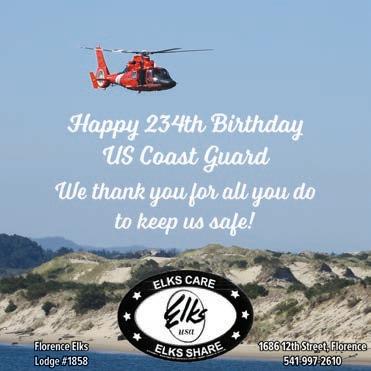
From Page 4
may lead to the Alert being decommissioned, Crusias said that the 210’ MEC class is slowly being retired.
“The 210’ MEC, one of our longest-standing assets, is slowly being phased out as a legacy asset as the OffShore Patrol Cutter (OPC) is brought online,” Crusias said. “Alert will be one of the last to decommission, given the outstanding work performed on her by both Coast Guard and contractors within the Pacific Northwest.”
Some of that outstanding work includes counterdrug operations where the Alert and her crew have seized thousands of kilograms of drugs in her time serving in the Pacific. Crusias detailed some of the Alert’s distinguished exploits.
“I can tell you that the cutter was the 2015 Department of Justice Office of
Counter Drug operational unit award winner,” Crusias said. “In the last year onboard, despite the pending homeport shift, we executed the largest open boat interdiction in over 15 years, totaling 4,950 kilograms of cocaine.”
While the ship and operations may have changed over the years, one thing that hasn’t is the connections made with his fellow servicemen. Zielaskowski has stayed in contact with people that he served with and forged lifelong friendships. The bond that is serving the country together builds, along with the shared experience of Coast Guard life, is something that people outside of the service can’t understand.
When asked what the Alert’s restationing meant to him, Zielaskowski said, “I miss it already. Whether it’s gone or not, I miss it. Because it was part of my life, it was my home away from home for a year and a half. I enjoyed the people that were on the ship with me, we all had our thing.”


Since 1908, Tillamook Bay and the surrounding waters have been patrolled by personnel from the United States Coast Guard and its predecessor, the Life Saving Service.
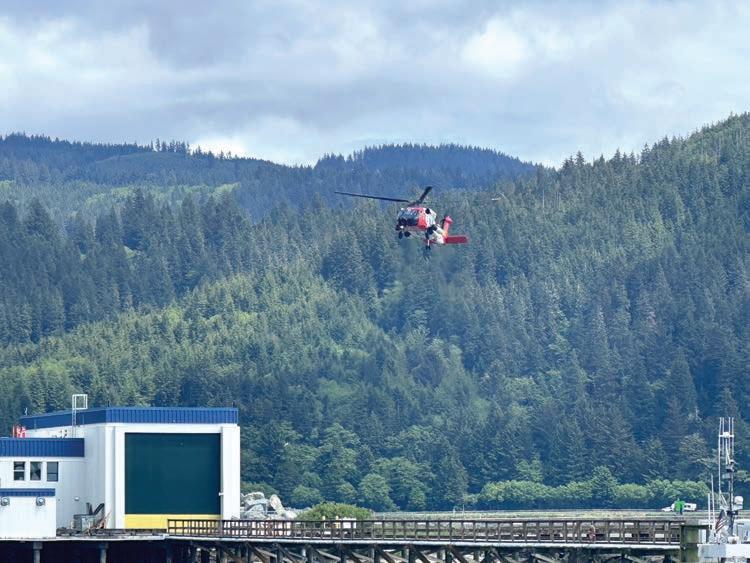
Today, 65 Coast Guard personnel are stationed at Coast Guard Station Tillamook Bay in Garibaldi, operating two lifeboats and a skiff to monitor the waters from Tillamook Head to Cape Kiwanda.
The first station to provide service to Tillamook Bay was built in 1907 and opened in 1908 at Barview Jetty as part of the United States Life-Saving Service, one of the two precursor organizations to the United States Coast Guard, which was formed in 1915. The first station featured a 26foot, manually propelled surfboat that was the only craft stationed in the bay for three decades.
In 1937, the coast guard began operating from a new boathouse a little over a mile and a half from the
mouth of the bay, just west of Garibaldi. Situated at the end of a 650-plus foot pier, the new boathouse featured rails in the floor to facilitate easier launching of the two, new, 36-foot motorboats that arrived a year after the boathouse’s completion in 1936.
The boathouse was manned by around 30 personnel, who continued to live in Barview until 1943, when new housing was constructed across Highway 101 from the boathouse.
In the mid-1960s, the next generation of boats arrived in Garibaldi, with two 44-foot lifesaving boats originally stationed in the Port of Garibaldi’s boat basin, before the current boathouse was opened in 1981.
The station’s 39 active-duty personnel and 26 reservists primarily focus their training activities on supporting the commercial fishing fleet operating in their waters, even though recreational craft represent

most traffic. In addition to search and rescue operations, the station also conducts law enforcement activities and works to prevent pollution in the marine environment. It is also the duty of the station commander to serve as the Captain of the Port, monitoring harbor access conditions and restricting traffic as necessary.
In addition to these duties, the guard members work to educate locals and visitors to the potential hazards of recreating and boating in the area’s waters.
Two 47-foot motor lifeboats are the main vessels used by the guard members in search and rescue operations, while a skiff is also housed at the station. The motor lifeboats can operate
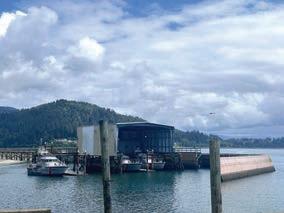
in 20-foot breaking waves and 30-foot seas and have been used in hundreds of rescues off the Oregon and Washington coasts.
The Coast Guard is well embedded in the local community after more than a century, and the community’s support was formally recognized earlier this year when Garibaldi was designated a Coast Guard City,
one of 34 across the country. In addition to restoring the historic boathouse, Garibaldians have also promoted Coast Guard history at the Garibaldi Museum and integrated those at the station into the community through traditions such as the annual waterball tournament against local fire crews during the Garibaldi Days festival.
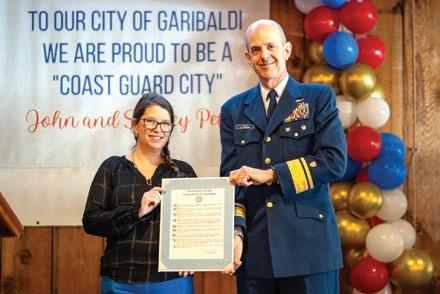

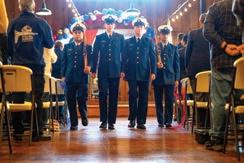
Country Media, Inc.
Citizens, city leaders and a large contingent of service members gathered on March 5, at the Old Mill Convention Center to recognize and cele-
brate Garibaldi’s designation as a Coast Guard City.
At the ceremony, Rear Admiral Charles E. Fosse, the commander of Coast Guard District 13, Mayor Katie Findling and a representative from Senator Jeff
Merkley’s office delivered remarks before a bagpipe rendition of Semper Paratus, the Coast Guard’s official song.
The ceremony marked the culmination of a multiyear process that began in

2022 and was spearheaded by former City Councilor Laurie Wandell, who also spoke at the ceremony.
Fosse spoke first and glowingly reflected on the relationship between the city and the Coast Guard, which began with the opening of a lifesaving station in 1908 at Barview Jetty. Since then, service members have come to expect a strong level of

support from the community, Fosse said.
Garibaldi joined 33 other cities that had previously received the designation, which recognizes cities that extend special consideration to service members to make them and their families feel at home.
Garibaldi was chosen in recognition of several initiatives they have taken to help
honor the Coast Guard in the city, including the restoration of the 1936 boat house that sits on the bay, preserving the history of the guard at the Garibaldi Maritime Museum and recognizing an annual Coast Guard Appreciation Day, with parade.
The selection process required review by congressional authorities as well as approval by the Coast Guard.

WILL CHAPPELL Country Media, Inc.
The historic United States Coast Guard boathouse in Garibaldi has been given new life as an education destination for students from across the Pacific Northwest since the Garibaldi Cultural Heritage Initiative took over in 2017.
Work by dedicated volunteers has helped to restore and maintain the 1936 boathouse and updates have made it better suited to welcome students for outdoor school and serve as a museum.
“There’s a lot of people from Garibaldi and the surrounding area their fathers, grandfathers, great grandfathers, (are) heroes and we want to put that out there,” said Steve Denning, the Garibaldi Cultural Heritage Initiative’s (GCHI) volunteer director.
The boat house was originally constructed between 1935 and 1936 to house two new 36-foot lifesaving boats, as well as a 26-foot, manually propelled surfboat that had previously been the only vessel stationed in Tillamook Bay. Located at the end of a 650-plusfoot pier, the boathouse previously contained three sets of rails, down which carriages holding the boats would be lowered into the water.
At the time, it was standard practice for the coast guard to construct boat houses in this manner, according to Denning, although the Tillamook Bay boathouse was the last built using this design.
Operations began at the boat house in 1937, after a delay in procuring the carriages to move the boats prevented a 1936 opening. For the first six years of the boathouse’s existence, guardsmen still lived in

the old station in Barview, until new housing opened across Highway 101 from the boathouse in 1943.
The boathouse’s mission began to scale down in the mid-1960s when two new 44-foot lifesaving boats were stationed at the Port of Garibaldi. For the next decade, the boathouse remained operational as guardsmen used the aging boats for towing practice, but by the mid1970s it was decommissioned before ownership was transferred to the Port of Garibaldi in 1980.
Over the next threeplus decades, the port leased the structure to businesses, first to a bait shop and then to a scuba diving instructor, who closed shop in the early 2010s. During this period the building’s upstairs was converted into living quarters and one of the three sets of rails was removed from the floor.
After sitting abandoned for several years, the boathouse came to the attention of Clair Thomas, retired natural resources education coordinator for the Tillamook School District and current pres-
ident of GCHI’s board of directors, in 2015. Thomas, along with other volunteers, began restoration work on the boathouse, which had
fallen into disrepair, and began holding field trips for students from local school districts almost immediately. By 2017, with work

since.
Port of Garibaldi Manager Mike Saindon said that teaming up with the GCHI to preserve the historic boathouse was an easy decision for leaders at the port.
“The port values and wants to preserve and share this area’s rich history,” Saindon said. “Partnering with the GCHI and their expanding programs is an honor and preserving the boathouse is very important to port staff and commissioners.”
progressing and educational activities increasing, Thomas helped to found the GCHI, which has held the lease and managed the boathouse
Now, the boathouse welcomes schoolchildren participating in outdoor school programs throughout the year, for hands-on learning opportunities about marine biology, robotics and other subjects. Thomas, who also coordinates educational activities at the boathouse,
See BOATHOUSE, Page 9

From Page 8
said that more than 1,000 students from as far away as Spokane had visited the boathouse for outdoor school in May alone.
Thomas also leverages the boathouse’s location to help local robotics teams practice their underwater skills, offering a series of workshops to learn to build and operate underwater robots. Thomas said that both the Tillamook and Neah-Kah-Nie robotics teams had participated, as well as teams from two charter schools, and that the waters of the bay provided an added challenge.
“Both of those teams will come and do things here because here, they have challenging situations, while there, they just have a pool,” Thomas said.
In addition to scholastic pursuits, the boathouse is also open to the public
on Saturdays and Sundays from noon to 4 p.m., containing exhibits relating to local history.
GCHI is a 501(c)3-registered, non-profit organization, which accepts donations and volunteers to help with ongoing maintenance and programs at the boathouse. The group is hosting a meeting on June 5, from 5-6:30 p.m. at the boathouse for residents to tell stories about local history.
Denning, who served in the coast guard at Tillamook Bay in the 1980s, said that hearing and sharing stories about the building, area and coast guard was one of his favorite aspects of volunteering at the boathouse.
“A lot of people come in, they have stories, they came in here for a reason, and a lot of times it’ll be something like this, ‘you know, my brother-in-law was in the coast guard,’ and they want to tell me about that experience and I want to hear it,” Denning said.
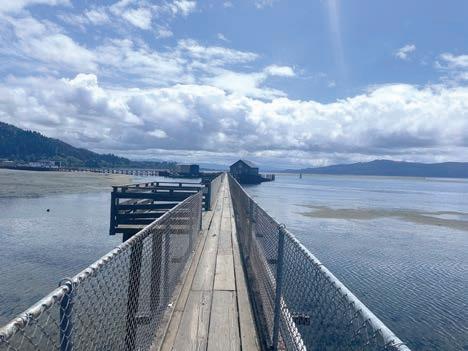



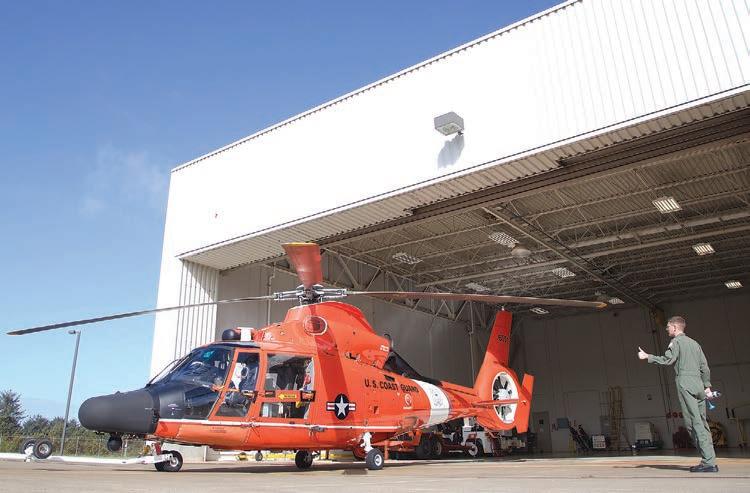
In the early 1980s, after a commercial fishing vessel went down off Newport and resulted in the loss of a life, members of the fishing community and local officials initi ated a push for a Coast Guard helicopter to be stationed in Newport to respond to search and rescue missions in the area. There was already an air base in North Bend, but response times from that station to emergencies further up the coast were costing lives.
1986, then Oregon Gov. Vic Atiyeh lent his sup port to the effort, urging Congress to “see the fed eral commitment and ap propriations necessary to ensure the establishment” of the air facility. Atiyeh cited a drowning of two young people swept of the rocks at Otter Rock, say -
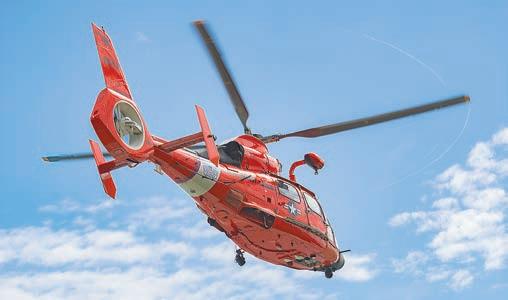
See NEWPORT, Page 11

From Page 10
ing, “They drowned while several hundred residents watched helplessly.”
Congress appropriated the money in 1986, and although still technically part of Air Station North Bend, the Newport Air Facility was created to cut response time by having a helicopter stationed in Newport around the clock.
And then after about 28 years of providing this much needed service to the central Oregon coast, this protection was very nearly lost. It was a time when federal agencies at all levels were scrambling to find ways to cut their budgets. In a budget re -
quest for fiscal year 2014 to the U.S. Department of Homeland Security by the Coast Guard commandant, Admiral Robert Papp Jr., the following sentence was included: “The Coast Guard will also consolidate regional assets where overlapping capabilities exist by closing air facilities in Newport, Ore. and Charleston, S.C.”
The possibility of the Newport facility being closed quickly created an uproar in the local community, which was soon echoed by state officials and Oregon’s federal legislators. Led locally by the Newport Fishermen’s Wives Association, the effort included condemnation by the city of Newport, Port of Newport, Lincoln County and the six Democrat members of
the Oregon Congressional Delegation.
Ultimately, the Newport Air Facility was given new life when the U.S. Coast Guard Act of 2015 was passed by Congress and signed into law by President Barack Obama. That legislation guaranteed funding for a Coast Guard rescue helicopter in Newport through at least Jan. 1, 2018.
Obviously that support still exists today because the needed funding remains, and it has been a decade now since the central coast nearly lost this much needed Coast Guard response capability. And over that 10-year period, there have been many rescues made and lives saved because that helicopter was ready to respond when needed.


A U.S. Coast Guard helicopter from the Newport Air Facility rescues a young girl at Yaquina Head in Newport, who was one several people swept to sea and stranded on the cliffs after being caught in a rip current while surfing at Agate Beach.


JEREMY C. RUARK Country Media, Inc.
U.S. Coast Guard Petty Officers Second Class Elijah Johnston is tasked with operating the Station Depoe Bay motor boats with a crew of four members.
“I am basically the boat captain,” he said.
Operating out of Depoe Bay can be challenging, according to Johnston.
“It has an absolutely tight harbor entrance,” he said. “It’s very narrow. It’s approximately 50-feet wide, which leaves narrow margins for error when you are transiting through there or towing another vessel, especially as the seas get bigger and the conditions become more challenging.”
The Fort Townsend, Wash. native has been a member of the Coast Guard for six years.
“I intend to be in the Coast Guard for 20 years,” he said.
Johnston said he finds rewards as a Coast Guard member.
“The security for myself and my family,” he said. “Obviously its a good job. There are excellent benefits. It pays well and it provides for my family. There’s a sense of satisfaction when going out on the water, assisting mariners, saving lives, saving property and saving homes, and leading, empowering and developing and my crew.”
Johnston said the Coast Guard is a good place to be.
“The Coast Guard is always looking for young, able-bodied people who want to serve their country, get out on the water and do some good in the process,” he said. “My advice to somebody who wants to join is to do well in school. Don’t get in trouble. Don’t get on the wrong side of the law. Anybody who has the right mentality and is willing to work hard can get in.
It’s very difficult to overcome those other things if you’ve made mistakes in your life.”

Life lessons learned
Johnston said the Coast Guard has guided his life develooment.
“I was originally a high
school dropout,” he said. “I went back to school when I was 20-years-old and got my diploma. I think because of some of those earlier challenges, I wasn’t
the greatest leader for a long time, but the service put me in a leadership position. I just didn’t have very good leadership skills. I definitely faced challenges
in inspiring and gaining the respect from the crew that I needed and just getting the job done.”

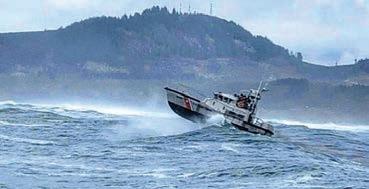
From Page 12
Station Depoe Bay was established in 1940 as a Search and Rescue motor lifeboat station.
The need for highly trained boat operators to conduct the many rescues through this inlet is what has made this Station a permanent fixture in this community.
The primary role of Station Depoe Bay is Search and Rescue with an emphasis in surf and heavy weather operations.
As one of only 19 surf stations in the Coast Guard, Station Depoe Bay members train and operate in seas up to 30-feet, surf up to 20-feet and sustained winds up to 50-knots.
Those challenges require an extensive and robust training plan in order to certify the Coast Guard members to operate effectively in such conditions.
Federal laws and
regulations also are enforced by the Coast Guard Station Depoe Bay members by conducting vessel boardings to ensure boaters meet all safety and navigation requirements. The members also respond to environmental hazards and accidents.
Station Depoe Bay utilizes three 47-foot Motor Life Boats approved for operations in heavy weather and surf conditions. The station crews also can use ground vehicles for landside response during beach and cliff rescue operations.


The Coast Guard Station Siuslaw River is out of sight to many residents, located in the trees west of Rhododendron Drive. The station was established in 1917 and remodeled in the 1980s.
However, personnel at the station remain ready to help and dedicated to serving the coast community.
BM1 Jared Barnes explained that the station responds most frequently to vessels that are disabled in the water, either from fuel or mechanical issues. He said distress calls for missing hikers, kayakers and other are also not uncommon.
Station Siuslaw River personnel also serve as law enforcement on the water, responding to everything from boaters under the influence to environmental protection calls.
The station’s area of responsibility is south the Siltcoos River, and north to Cape Perpetua.
Asked how often the station works with personnel from Stations Yaquina
River in Newport and Station Umpqua River in Winchester Bay, Barnes said if something happens near the edges of each station’s area, both will usually respond.
“If we don’t know who can get there first, we both go,” he said. “We work pretty closely with the other stations.”
Asked how far up the Siuslaw River personnel will respond, Barnes said, “All the way to Mapleton.”
The station is staffed by 30 to 36 personnel, using two 47-foot lifeboats and a 29-foot response boat that can easily get to Mapleton.
Asked if Coast Guard personnel will go inland to help other first responders, Barnes said it’s decided on a case-by-case basis.
“We work with first responders on everything,” he said. “If we pull someone out of the water and they’re having a medical emergency, we’re going to drop them off to EMS. We have a standing policy to meet them in Old Town or down here. We work with law enforcement agencies all the

time, Oregon Department of Fish and Wildlife, and park rangers.
He said boat personnel don’t assist with inland emergencies as much as the air crews do, and helicopter personnel have transported injured loggers from mountain regions.
Coast Guard personnel will assist with marine mammal entanglements by helping locate and report
the information to rescuers, but does not have divers or personnel specialized to deal with it.
Having been with the Coast Guard for 19 years, BM1 Barnes recommended it as a career to high school students considering it.
“The Coast Guard is a great way to set your life up
for success,” he said, noting that initiatives will allow them to save money and have their college paid for, as well. “When you get out of the Coast Guard at 22, you are set up to conquer life.”
Asked what careers one could move into from the Coast Guard, Barnes said, “I think it sets you up for almost any career because it’s just a good work ethic.”
Fireman Aidan Gunderson is just starting his Coast Guard experience at age 20, in his third month at Station Siuslaw River.
He said he made the choice because he was in a job he didn’t like and a place that was too expensive. With a lot of family in the Navy and the Coast Guard, was left to choose.
“The Coast Guard recruiter did a better job than the Navy recruiter,” he laughed.
He explained that the Coast Guard “solved 90 percent of my problems,” offering, food, shelter, education, and a way to save money. He said basic training is tough but is worth it, adding that he has signed on for a six year enlistment.
Saying he hopes to move into aviation, he feels the Coast Guard is a great first step.
Gunderson said life with the Coast Guard is just what you see in tv shows and promotional materials, and has exceed his expectations.
He said a down day at the station is pretty routine,
See SIUSLAW, Page 15
From Page 14
involving boat maintenance checks, cleaning and training, as well as studying.
“It’s a really nice environment here,” he said. “Everyone is always willing to help out.”
Taking that step
MK2 engineer Jose Rios has been with the Coast Guard for four years, all but six months at Station Siuslaw River.
Rios also spends time inspecting boats and doing maintenance, while also standing ready to answer calls for service.
Towing distressed vessels is common, but Rios said he has also responded to rescues of people from a sinking boat on the ocean and swimmer in distress in the Siuslaw River. He will leave Siuslaw this summer but plans to stay in the Guard for 20 years.
He said he will transfer to a larger station in Alameda, Calif. where he will work national security details.
Asked what advice he had for students considering the Coast Guard, he said they should give it a try.
He said it was a dream for him, and learning English was difficult, but he was able to get in after 10 years.
“It’s been good, I would
recommend it,” he said, adding that saving people and being vigilant of their safety has been the most rewarding aspect for him.
“It feels good when people say, ‘thank you for your service,’” he said, “You feel like you’re not here only for your self but you’re here to watch out for your people.”
Asked if he’d like to add a message to the people of Florence, Rios said personnel are here to help.
“We always like to help and if you ever need anything, anyone from the community can come in and ask for help,” he said. “Say, even if you’re moving and you need help putting stuff in your house, we are always willing to help.”

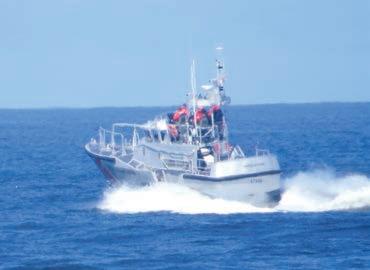


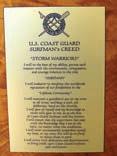

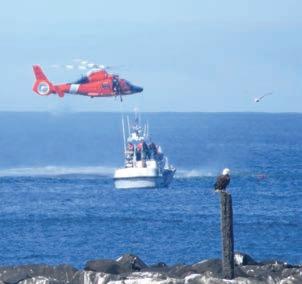
JEREMY C. RUARK Country Media, Inc.
U.S. Coast Guard Officer in Charge Amber Archer began her responsibilities June 7, 2024, at Station Depoe Bay.
It is the first time for her as a Chief Officer, but not for serving along the Oregon Coast.
“It’s kind of coming home to me,” she said.
“While I am not an Oregon native, I’ve served along the Oregon Coast over the past 12 years, so it feels like home overall.”
Archer’s in-laws live close by Station Depoe Bay and her parents live in Tillamook.
Background
Archer comes from Woodland, California, a farming community outside Sacramental, with an agri-
cultural background. She joined the Coast Guard in 2009 and was assigned out of boot camp to a navigation unit at San Francisco. She also took a turfmen training course, a high qualification in the United States Coast Guard for small boat operations. That took her to the Coast Guard Tillamook Bay Station in 2012 where she spent six years. She certified as a surfmen in 2015.
In 2018, Archer transferred to Station Coos Bay where she worked for six years advancing to Operations Petty Officer and Chief Surfmen Trainer, eventually taking over as the Executive Petty Officer position.
Archer is responsible overall for the Station
Depoe Bay crew.
“That includes our operations, the mission, making sure the crew is trained up to respond,” she said. “The crew is going to do what the crew is trained to do. We are really great at the mission, our training program, and our operations. Our boat crew are trained well. So, I oversee the search and rescue side, the advocacy for the crew, and making sure we have what we need to meet the public’s need and to meet my crew’s needs as well.”
Archer said her main challenge at Station Depoe Bay is the Coast Guard’s aging platforms.
“Our 47-foot motor life boats have been in service since the early 90s and they are going through a life-overhaul,” she said. “So, right now we are in the process of reconfig -

uring our power plants. They coming out right now. It’s trying to make sure that hopefully we’ll get the new overhauled boats to keep us going.”
Archer’s husband was prior active duty at Coast Guard Station Depoe Bay, which give her insight into the challenges of operating in a small bay.
“I have a little bit of working knowledge of Depoe,” she said. “It is one of those holes, you don’t really know until you are out there, so being involved there with my crew gives me the real appreciation of the uniqueness and the challenges of it, and the professionalism that is required skilledbased wise to operate in the bay. It definitely takes a different skill set.”
Archer and her husband have three boys, ages 15, 4, and 2.


DAVID HAYES
Country Media, Inc.
Brian Moitoso’s first experience with the Coast Guard was not the ideal recruitment moment.
Moitoso, 46, recalls today that when he was in high school in California, his father asked what his plan was after he graduated.
“I told him I don’t have a plan,” Moitoso recalled.
He said, “Well, you’ve gotta start paying some bills.”
He suggested his son start looking at military options. His father had coworker in the Coast Guard Reserve and suggested starting his search there.
The recruiting office had displays of what the Coast Guard does. Moitoso walked in and grabbed some pamphlets off the wall.
One of guys behind the desk stood up and said, “Hey, can I help you?”
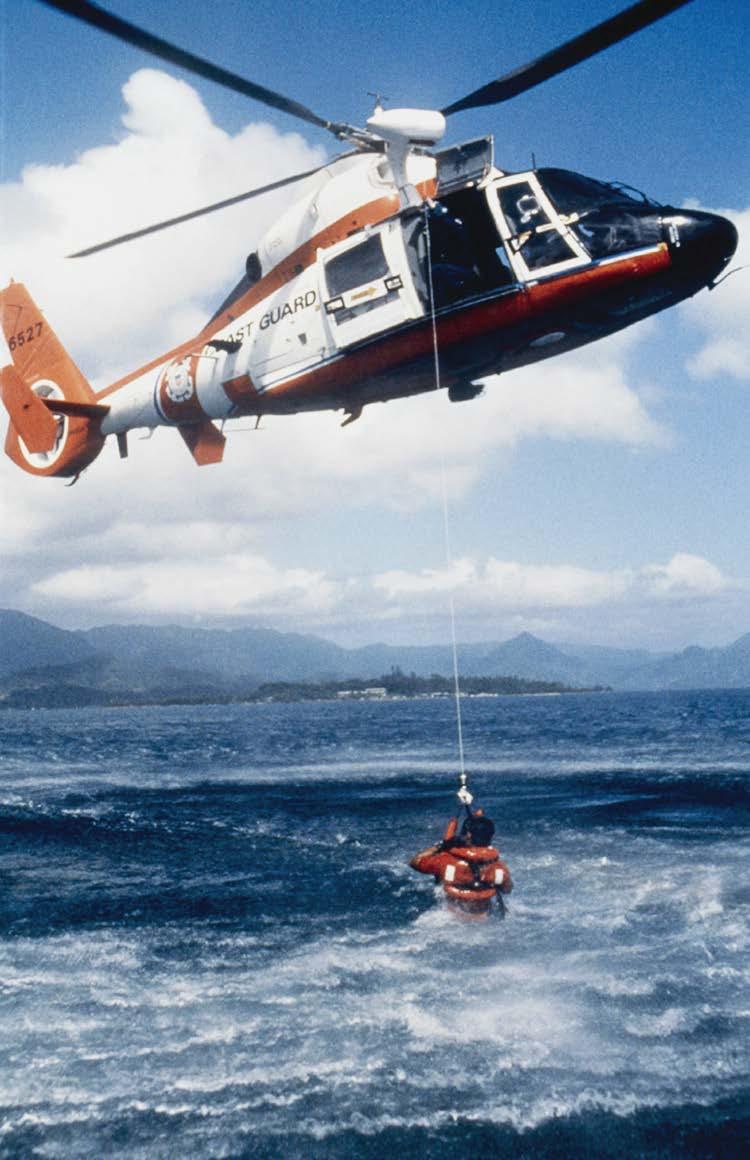
“I said, ‘Nope,’ turned around and walked out,” he remembered. “That was my first experience with the Coast Guard.”
Looking back, Moitoso is grateful to all the skills he learned in his nearly 22 years in the Coast Guard that have translated to working part-time as a handyman out of Sheraton, Oregon.
After returning to that recruiting office and swearing in, Moitoso served aboard vessels patrolling the Great Lakes, overseas operations out of Kuwait and Bahrain and
finally up and down the West coast, from Seattle to Newport.
Ironically, he blew right past that four-year plan to fulfill his enlistment requirement and move on.
“After being in a while, I started thinking I could do this 20, 30 years. At the time, it seems like forever. Until you get there, man was a blink of the eye,” Moitoso said. “Of course, you wish you could go back and do things differently. But hindsight is 20/20. But I don’t regret a day of it. Definitely recom mend it to anybody. I had a really good time.”
While his favorite location being stationed was in Hawaii, and the most interesting was the cutters assigned to while in Kuwait, Moitoso said the most rewarding assignment was aboard the Polar Sea, an ice breaker out of Seattle.
“When I was on the Polar Sea up in arctic for months, there was literally nothing around but ice,” Moitoso recalled. “Stuff breaks. The only thing you’ve got are the guys next to you. You can fix whatever is broken and carry on with day. You make sure there is hot water, steam in the galley, and the engines keep turning.”
He added by necessity, aboard such small vessels as the cutters, you became a jack of all trades.
“You have to be a mechanic, a plumber, an electrician, and a welder. Because sometimes

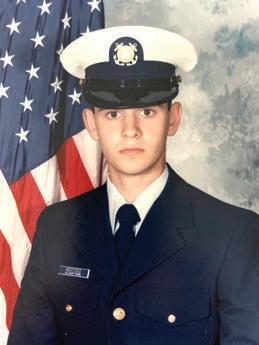
those guys aren’t around. Knowing that stuff, has definitely helped me now, being a handyman and doing stuff on my own. I don’t have to pay someone to come over and replace sink or water lines,” he said.
As a civilian, Moitoso recommends anyone in today’s younger generation to explore serving their country in the military. Explore them all, he added,
just don’t forget about the Coast Guard.
“The Coast Guard is always forgotten. It’s the smallest service. But when I talk to people, or they ask about it, I tell them the Coast Guard is the only one that actually has a job outside of wartime,” he said. “You’re out there saving lives. Stopping drugs on the water. Environmental production. Scrubbing the ducks
covered in oil. Pilots doing search and rescue. Guys doing drug running stuff, there’s that crazy video of that Coastie banging on that semi-submersible. Anything you want to do in the world, you can do in the Coast Guard.”
Moitoso finished his career in North Bend, as a readiness operations chief. After he retired, he and his wife Megan bought and renovated a home in Independence. They moved
to Sheridan and soon had their first child, son Hunter, who’s now four, and years away still from deciding to follow in his father’s deck shoes.
He said his own father is extremely proud of the decision he made and stuck with it.
“He raised me that way. You make a decision, it’s on nobody but yourself. Take pride in yourself, whichever way you turn out to be,” Moitoso added.
ROGER GITLIN Country Media, Inc.
The United States Coast Guard celebrates its birthday August 4, 1790. The USCG created by the Revenue-Marine at the request of Secretary of the Treasury Alexander Hamilton. The Coast Guard is the oldest continuously operated Naval service of the United States. Over the centuries, the Coast Guard has evolved. The modern Coast Guard was formed by a merger of the U.S. Revenue Cutter Service and the U.S. Life Saving Service on January 28, 1915.
In 1939, the U.S. Lighthouse Service was merged into the U.S. Coast Guard. As one of the country’s six armed services, the U.S. Coast Guard has deployed to support and fight every
major U.S. war since 1790, including the Global War on Terrorism.
The Coast Guard’s authorized force strength is in excess of 40,558 active duty personnel and 7,724 rereservis. The U.S. Coast Guard Auxiliary has 21,000 uniformed volunteers, include the active Auxiliary in Crescent City.
The Coast Guard presently situates under the jurisdiction of the Department of HomeLand Security.
The Coast Guard Public Affairs Office updated the following information for Crescent City and Del Norte County: It’s role: Port and Waterway Security, Drug interdiction, Aids to navigation, Search and Rescue, Marine safety, Unregulated fishing, Defense readiness, Migrant interdiction, Marine

environmental protection, Ice operations and Law enforcement
• During the Covid crisis of 2020, the Coast Guard pulled out of the Crescent City Harbor and relocated its operations to the CG Station, Checto River in Brookings, Oregon by service assets and CG Sector Humboldt Bay, in McKinleyville by air asset. The Coast Guard Auxiliary will be resuming dockside examinations for boats in the near future.
• The Coast Guard’s primary missions in Del Norte include Search and


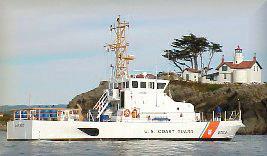
Rescue (SAR), Living Marine Resources (LMR) and Aids to Navigation (ATON). SAR involves responding to calls of distress on the Coast and inland. LMR focuses on regulating commercial and recreational fishing on the coast and ATON maintain navigational aides used by mariners to ensure safe Navigation on the rough coastline.
• Over the past 12 months, the Coast Guard has responded to 12 distress calls in the vicinity of Crescent City. The majority of the calls are responding to disabled boats around the Harbor and out to 20 miles offshore.
• The Coast Guard welcomes invitations to par-
ticipate in public events or workshops. In the past the Coast Guard has participated in Water Safety Day in Crescent City.
The Coast Guard Sector Humboldt Bay may be reached at (707) 8396103.
The United States Coast Guard in Your Service

has long history of service
Station Yaquina Bay has a long history in Newport —


in 1906. The current facilities were erected in 1944, after the first building was destroyed by fire. A modern annex with berthing, dining, haul out facilities, as well as emergency power supplies, was completed in 1983. Work is currently underway to renovate and restore buildings on the site as needed.
Station Yaquina Bay’s area of responsibility extends from Cape Perpetua on the south end to Spencer Creek on the north, totaling 27 miles of coast. With the primary mission of search and rescue, the station responds to hundreds of cases per year. In addition to search and rescue, another primary mission at Yaquina Bay is law enforcement.
When needed, Coast Guard crews will also assist police departments, fire departments, county search and rescue, and county marine patrol with emergency
Slade, who has been with the Coast Guard for nearly 27 years.
Slade joined in September 1997 and was first assigned to the Mellon, a 378-foot cutter out of Seattle, then she spent a year at Station Woods Hole on the East Coast before deciding she wanted to be a surfman.
Surfmen are the Coast Guard’s best, most-highly trained lifeboat drivers, rated to power into 20-foot or higher waves. Slade spent seven years assigned to the National Motor Lifeboat School at Cape Disappointment, in Ilwaco, Washington, before receiving her next assignment in Newport, where she was operations officer and surfman trainer for five years.
From there, Slade went to Station Depoe Bay as executive officer. When she received her commission as a warrant officer, she did her first tour as such on
cisco for three years and then did a four-year stint in command at Station Coos Bay before transferring to Newport to take charge at Station Yaquina Bay.
Without a doubt, the Coast Guard has had a major impact on Newport and the surrounding communities, safeguarding life and property as part of its day-to-day mission. And the community supports its Coast Guard. In March of 2005, Newport was recognized as a Coast Guard City, a designation it still holds nearly two decades later.
On the city of Newport website, it states, “The men and woman of the Coast Guard are an important part of any community with strong economic ties to the oceans and waterways. We are fortunate to have these guardians in our community, and we are pleased to hold the honor of being a Coast Guard City.”
